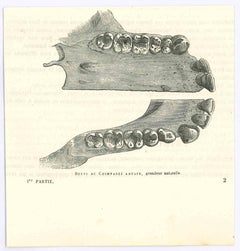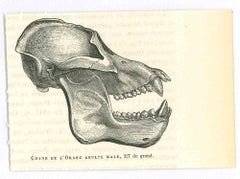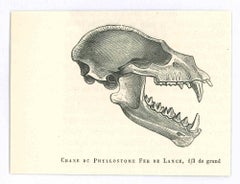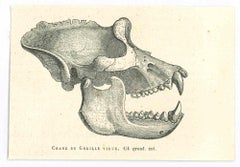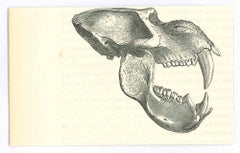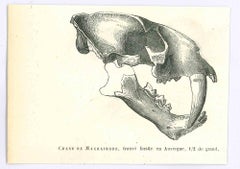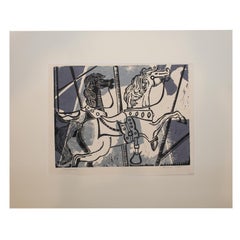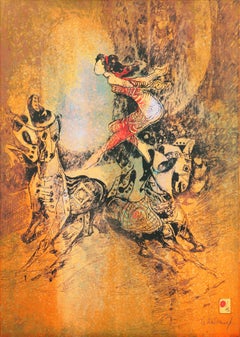Teeth Animal Prints
to
6
Overall Width
to
Overall Height
to
6
6
5
1
81
2,717
1,740
1,451
1,084
860
565
493
456
421
402
357
353
316
253
218
191
174
148
146
6
5
Art Subject: Teeth
The Teeth - Original Lithograph by Paul Gervais - 1854
By Paul Gervais
Located in Roma, IT
The Teeth is an original lithograph on ivory-colored paper, realized by Paul Gervais (1816-1879). The artwork is from The Series of "Les Trois Règnes de la Nature", and was published...
Category
1850s Modern Figurative Prints
Materials
Lithograph
The Skull - Original Lithograph by Paul Gervais - 1854
By Paul Gervais
Located in Roma, IT
The Skull is an original lithograph on ivory-colored paper, realized by Paul Gervais (1816-1879). The artwork is from The Series of "Les Trois Règnes de la N...
Category
1850s Modern Animal Prints
Materials
Paper, Lithograph
The Skull - Original Lithograph by Paul Gervais - 1854
By Paul Gervais
Located in Roma, IT
The Skull is an original lithograph on ivory-colored paper, realized by Paul Gervais (1816-1879). The artwork is from The Series of "Les Trois Règnes de la N...
Category
1850s Modern Animal Prints
Materials
Paper, Lithograph
The Skull - Original Lithograph by Paul Gervais - 1854
By Paul Gervais
Located in Roma, IT
The Skull is an original lithograph on ivory-colored paper, realized by Paul Gervais (1816-1879). The artwork is from The Series of "Les Trois Règnes de la Nature", and was published...
Category
1850s Modern Animal Prints
Materials
Paper, Lithograph
The Skull - Original Lithograph by Paul Gervais - 1854
By Paul Gervais
Located in Roma, IT
The Skull is an original lithograph on ivory-colored paper, realized by Paul Gervais (1816-1879). The artwork is from The Series of "Les Trois Règnes de la Nature", and was published...
Category
1850s Modern Animal Prints
Materials
Paper, Lithograph
The Skull - Original Lithograph by Paul Gervais - 1854
By Paul Gervais
Located in Roma, IT
The Skull is an original lithograph on ivory-colored paper, realized by Paul Gervais (1816-1879). The artwork is from The Series of "Les Trois Règnes de la Nature", and was published...
Category
1850s Modern Animal Prints
Materials
Paper, Lithograph
Related Items
"Carousel" Blue Abstract Horse Serigraph
By Barbara Maples
Located in Houston, TX
Blue toned serigraph of a carousel with horses. The work is signed and numbered by the artist. It is not framed but comes with a white matte.
Artist Biography:
Barbara Maples...
Category
1950s Modern Figurative Prints
Materials
Lithograph
'Equestrian Actress', Modernism, Circus, Vietnamese, French, Horse, Acrobats
By Hoi Lebadang
Located in Santa Cruz, CA
Signed lower right, 'Lebadang' and with number and limitation, 163/215, lower left.
Also known as Dang Lebadang (Vietnamese-French, 1922-2015) this not...
Category
1960s Modern Animal Prints
Materials
Paper, Lithograph
Lithograph after Georges Braque
Located in Collonge Bellerive, Geneve, CH
Lithograph after Georges Braque
From the deluxe art review, Derrière le Mirroir
1964
Printed signature
Dimensions: 38 x 28 cm
DLM No. 148, 1964
Edition: Foundation Maeght at Saint P...
Category
1960s Modern Figurative Prints
Materials
Lithograph
'Circular Motion' original lithograph signed by Georges Schreiber
Located in Milwaukee, WI
In this lithograph, Georges Schreiber focused on the thrill of the circus, taking its circular composition from the central ring. Here, acrobats perform amazing feats of agility on t...
Category
1940s American Modern Animal Prints
Materials
Lithograph
Alfred Bendiner, The Son also Raises
Located in New York, NY
No matter the seriousness (or lack thereof) of the subject, everything is always beautifully drawn on the lithographic stone by Bendiner.
Here a bull fight has gone amiss. Perhaps ...
Category
1940s American Modern Animal Prints
Materials
Lithograph
Alberto Giacometti - Original Lithograph
Located in Collonge Bellerive, Geneve, CH
Alberto Giacometti - Original Lithograph
1964
Dimensions: 38 x 28 cm
From the journal Derrière le Miroir No. 148, 1964
Edition: Foundation Maeght at Saint Paul
Alberto Giacometti...
Category
1960s Modern Figurative Prints
Materials
Lithograph
Alfred Bendiner, On Vacation
Located in New York, NY
No matter the seriousness (or lack thereof) of the subject, everything is always beautifully drawn on the lithographic stone by Bendiner.
In this 'Day at the Beach' scene Bendiner h...
Category
1940s American Modern Animal Prints
Materials
Lithograph
Face of Peace - Lithograph
Located in Collonge Bellerive, Geneve, CH
Artist: Pablo Picasso (after)
Medium/publication: One of 29 lithographic reproductions after original drawings as published in the book Paul Eluard, "Le visage de la paix" (Paris: Ed...
Category
1950s Modern Animal Prints
Materials
Lithograph
Emilio Vedova - Original Lithograph
Located in Collonge Bellerive, Geneve, CH
Emilio Vedova - Original Lithograph
Abstraction
1961
From the art revue XXe Siecle
Dimensions: 32 x 24
Edition: G. di San Lazzaro.
Unsigned and unumbered as issued
Category
1960s Modern Figurative Prints
Materials
Lithograph
Max Ernst - The Soldier - Original Lithograph
By Max Ernst
Located in Collonge Bellerive, Geneve, CH
Max Ernst (1891-1976)
Georges Ribemont-Dessaignes, La Ballade du Soldat, Pierre Chave, Vence, 1972
Colour lithographs on Arches paper
1972
Edition : 199
Dimensions: 40 x 30 cm
Refe...
Category
1970s Modern Figurative Prints
Materials
Lithograph
Le Goût de Bonheur: one plate (portrait)
Located in Collonge Bellerive, Geneve, CH
Artist: Pablo Picasso (after)
Medium: lithograph, Arches paper
Portfolio: Le Goût de Bonheur
Year: 1970
Edition: Total of 1998 copies (666 each in G...
Category
1960s Modern Animal Prints
Materials
Lithograph
Georges Braque - Original Lithograph
Located in Collonge Bellerive, Geneve, CH
Georges Braque - Original Lithograph
1963
Dimensions: 32 x 24 cm
Andre Sauret, Monte Carlo
The father of Cubism
Three Cubist that distinguishes art historian periods were initiated and developed by Georges Braque: The Cubist Cézanne (1907-1909), Executive (1909-1912) and synthetic (1912-1922).
Post-Impressionist and fawn, Braque no longer adheres to the contingency of a decorative way or the other. Cézanne’s paintings exhibited at the Grand Palais during the retrospective of 1907 are a revelation: Cézanne sought and invented a pictorial language. In his footsteps, Braque went to the South with the reasons of the Master. He returned with Estaque landscapes and surprising Ciotat it keeps Cezanne geometric model and retains the “passages” continuity from one surface to another to create the sensation of “turning around” of the object represented. But he wants to go after the consequences of the vision of Cezanne. In his paintings Houses in L’Estaque (1908) it simplifies the volumes of houses, neglects detail by removing doors and windows: the plastic rhythm that builds the table. Large Nude , a masterpiece of the period, can be considered the first work of Cézanne cubism .
Systematizing and deepening Braque discoveries open the door analytical cubism. In 1909, his painting became more cerebral than sensual. The pattern is recreated in the two-dimensionality of the canvas, leaving aside any illusionistic perspective. In Still Life with Violin, objects are analyzed facets according to their characteristic elements, each facet referring to a particular view of the object. There are so many facets of points selected view: Table reflects the knowledge of the object and the ubiquity of the eye. Moreover, Braque is looking for the essence of the objects in the world rather than their contingency, which explains the absence of light source and use of muted colors (gray, ocher), contingent aspects of the object . But formal logic has stepped facets, erased any anecdote to the object and ultimately led to his painting a hermetic more marked on the edge of abstraction (see the series of Castle Roche-Guyon ).
Braque, anxious to keep the concrete and refusing at all costs that the logic of Cubism takes the paintings to abstract, reintroduced signs of reality in his paintings in 1912 marks the beginning of Synthetic Cubism. Historians speak of “signs of real” rather than reality because what interests Braque, this is not to put reality into a table, but to create a painting which, by its language, refers to the real. To do this, he invented two major techniques XX th century inclusions and contributions. The inclusions consist of painting objects that have no real depth, materials (wallpaper in Nature morte aux playing cards faux wood is a pictorial inclusion) or letters (calligraphic inclusion in Portuguese ), made first brush and a few months later stencil. Contributions are defined in contrast with the collage on canvas of foreign materials: glued or sand paper, sawdust, etc.. Regarding the collages, Braque used for the first time in September 1912 a piece of adhesive paper imitating faux wood Compote and Glass , then the packet envelope of tobacco Bock in 1912-1913, or an advertisement in Damier , 1913). Inputs and inclusions refer to an external object in the table, without “emulate” this object. Away from their appearances, objects are represented in closest essence of the objects in the real world sense.
This is also the time of Synthetic Cubism that Braque invented paper sculpture. There are, unfortunately, and no one is living proof of a photograph makes it possible to realize: Paper and paperboard.
Métamorphoses period(1961-1963).
In 1961, Georges Braque worked on a Greek head for the Louvre, which obsesses him, and he wishes to free his mind. He tried several times to bring out the paint and the result was unsatisfactory. He thinks the ultimate metamorphosis its Greek head projected in three dimensions. He calls in his studio of Baron Heger Loewenfeld, master lapidary, and he communicates his enthusiasm during the “fateful encounter.” Nine months later, in honor of the eighty years of Georges Braque, Heger Loewenfeld offers the Master of the ring Circe: the famous Greek head finally exorcised, carved in an onyx. Braque Loewenfeld then asked to identify other issues that haunt him.
From dated and signed by Georges Braque, Heger gouaches Loewenfeld shapes works in the fields of jewelery, lapidary art...
Category
1960s Modern Figurative Prints
Materials
Lithograph
